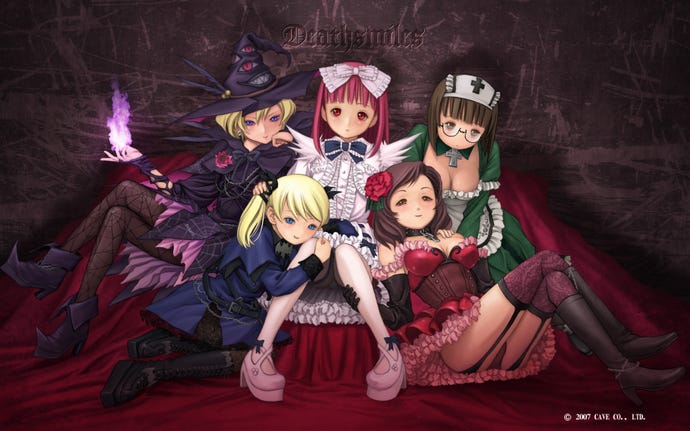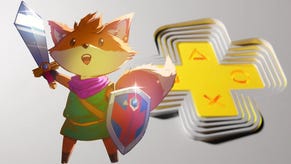JPgamer: Bullet Heaven
With shmup specialists Cave seemingly pulling out of the West, what better time to have a look back at some of their best work? Three, two, one, go!
This article first appeared on USgamer, a partner publication of VG247. Some content, such as this article, has been migrated to VG247 for posterity after USgamer's closure - but it has not been edited or further vetted by the VG247 team.
A few days ago, the official English language Twitter account for Japanese developer Cave posted an unfortunate and sad message.
"I know it's sudden," read the message from Cave's Masa-King, "but CAVE World (EN) twitter account will be shut down on Feb 28, 2014. The latest information will be made by cavegames on twitter in Japanese. I apologize for the inconvenience and thank you for your many years of support."
And with that, an era quietly ended as Cave retreated to its native Japan, leaving Western bullet hell fans surprised and frustrated.
It's been a while coming, to be honest; Cave has a number of strings to its bow, and the shoot 'em up sector was just one of those strings. The company as a whole has gradually been pivoting more towards the lucrative mobile and social games sector than the danmaku shmups most Western gamers tend to associate with them -- reports date back to 2012 in which Cave complained of stagnation in retail, causing many of its packaged console titles to fail to meet their expected sales targets. Meanwhile, free-to-play mobile and social games are huge in Cave's native Japan, so it's natural for them -- from a business perspective, anyway -- to want to go where the money is, as unfortunate as that might be for shmup fans.
Still, Cave's apparent retreat from English-speaking territories is no reason to mourn just yet, since they still have a ton of games available for play on both consoles and portable devices. Here are four of my favorites -- what are yours?
DoDonPachi Resurrection (aka DoDonPachi Dai-Fukkatsu)
DoDonPachi Resurrection's excellent iOS incarnation was actually my introduction to danmaku shooters as a whole a few years back. Frustrated by the general quality and copycat nature of most iOS games that were hitting the market each week -- a frustration I still have today for the most part -- a friend and colleague recommended that I give this game a go. After overcoming that initial hurdle of mistakenly assuming $7.99 was "expensive" for a game -- it may be expensive for an iOS game, but compared to other platforms, it's still a great deal -- I downloaded it and found myself immediately addicted.
DoDonPachi was initially bewildering to me, since it just appeared to be a chaotic mess of things exploding into showers of gold stars married to a seemingly indecipherable scoring system. The thumping electronic soundtrack -- way better on the iOS version than the Xbox version, in my opinion -- and gorgeous, colorful 2D visuals kept me interested though, and I kept playing until I started to feel like I had a better idea what was going on.
It didn't take long for me to start recognizing the conventions of danmaku shooters. I began to get the hang of navigating my ship through seemingly impenetrable curtains of bullets by focusing on its tiny weak spot rather than worrying about the whole sprite. I started to get my head around the scoring system, which rewarded relentless "combos" of destroying enemies in one mode, and finding the balance between risky flying and collecting rewards in the exclusive "Smartphone Mode." Most importantly, though, I was having fun -- even though the game was repeatedly and mercilessly killing me off without remorse.
DoDonPachi Resurrection is also available on Xbox 360 if you'd rather play on a big TV or with an arcade stick -- highly recommended, incidentally, though the touchscreen controls of the mobile versions are exemplary. It may not be the most immediately accessible of all Cave's shooters -- be prepared for a stiff challenge! -- but for my money it's one of the best.
Deathsmiles
Available on both mobile and Xbox 360, Deathsmiles is, in contrast to DoDonPachi Resurrection, one of the more easy-to-get-into of Cave's catalog. Unfolding from a side-on rather than top-down perspective, the game casts you in the role of one of several different young girls, each of whom has their own unique attack patterns and subtleties of control.
Like DoDonPachi Resurrection, Deathsmiles features a scoring system that is initially confusing, but which a little play -- or Internet research -- will help you get your head around. Essentially, it's about collecting items, to boost your score, and in order to get enemies to drop the maximum possible amount of score-boosting items, you need to hit them with the correct weapon -- either the rapid fire shot you get by tapping the fire button, the powerful laser you get by holding it down, or the "lock-on" shot mapped to another button. Making a run on Deathsmiles for a high score thus becomes highly technical -- you need to learn the attack patterns along with which of your weapons you should be using, not to mention the idiosyncrasies of each of the girls' control methods and weaponry.
That said, if you just want to shoot things, Deathsmiles caters to that style of play, too. Infinite continues mean that you can just start playing and keep blasting away until you reach an ending without having to worry about high scores, and there's nothing wrong with playing in this way if you find the higher difficulty levels or the prospect of the game's more technical aspects somewhat daunting.
Deathsmiles is also noteworthy for having an amazing soundtrack and some delicious 2D visuals -- all screen-filling monsters, huge explosions and enemies that are bursting with personality. The iOS version also adds an interesting new way to play with a new character -- plus, like DoDonPachi Resurrection, the mobile port features excellent touchscreen controls that a lot of other developers could learn a lot from.
Akai Katana Shin
Akai Katana Shin was brought to the West by Rising Star Games, and attracted widespread acclaim from a variety of Western publications. Like Deathsmiles, it is a horizontally-scrolling shooter rather than Cave's usual top-down fare, this time adopting a peculiar aesthetic that blends anime-style teen samurai heroes with World War II-inspired military hardware. It really works in the game's favor, though; the muted tones of the intricately-drawn backdrops contrast sharply with the bright pastel colors of the bullets, making it immediately easy to see where the danger zones on the screen are.
In keeping with Cave's other output, Akai Katana features a somewhat convoluted scoring system that takes a little exploration or research to truly master. In fact, there are three different game modes altogether, each of which have subtle changes to the scoring mechanics, giving veterans the opportunity to test their skills against the modes' various nuances. In this case, the main mechanic you need to learn is the difference between your normal and Spirit forms, with the latter offering you invulnerability as long as you don't fire your weapon. High scores come from filling the screen with bullets, then dispatching enemies while in Spirit form, making for exhilarating risk-vs-reward situations as you try to work out whether or not you can survive the next barrage intact.
Of all the Cave games I've played, this is probably the most difficult to get into -- but at the same time, it's also one of the most rewarding. Once you have a firm grasp of the systems at play in the game, it's immensely satisfying to rack up a score than extends into the multi-millions and even billions. Before that, it may be a little bewildering -- but give it some time and you'll find an incredibly satisfying experience that proves surprisingly addictive.
Muchi Muchi Pork!
Catgirls and monstergirls are nothing new to anime fans, but how about pig girls? That's exactly what you get in Muchi Muchi Pork, one of Cave's less well-regarded but very accessible shooters that stars a cast of busty young ladies with pig ears, whose transportation method of choice appears to be a flying bicycle.
Muchi Muchi Pork's theme is ultimately irrelevant to the gameplay, though, as it is in most of the developer's other titles. This is, once again, a game about scoring as many points as possible, with the main mechanic in this case being the interplay between your rapid fire shot and powerful Lard Beam, and how using these two weapons affects the score medals enemies drop. Fire your Lard Beam and you'll release more score medals; let up on the Lard Beam and you'll automatically suck in the medals, but there's a twist -- let any fall off the screen and their value drops significantly, so you'd better make sure you grab them all.
Muchi Muchi Pork's console release is notable for a couple of other reasons -- firstly, it came in a double pack with its stablemate Pink Sweets (from the same designer Shinobu Yagawa) and also it is one of the relatively few Xbox 360 games to be completely region-free, making it safe to import for Western gamers with unmodded consoles. Use of Japanese text is minimal, even in the menus, so you can safely and confidently pick up the double pack and get two enjoyable bullet hell titles for the price of one. Neither Muchi Muchi Pork nor Pink Sweets are perhaps Cave's finest work -- at least partly due to their relative age compared to the other titles outlined here -- but they are among its most accessible titles, making them good starting points for those looking to explore this type of game for the first time.












